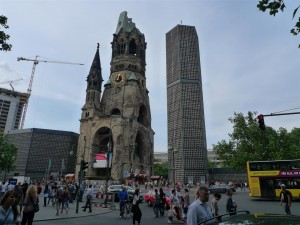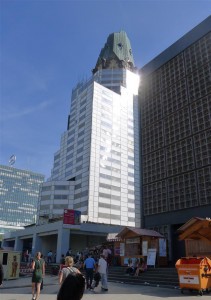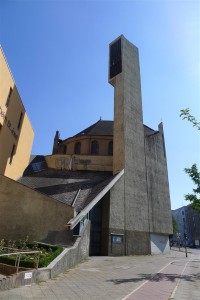Berlin was essentially flattened in World War II. In the years that followed the war, the buildings that were deemed worth saving were rebuilt, with varying degrees of faithfulness to their original appearance. They are now termed “Albau.” In contrast, much of the housing stock in Berlin is relatively uninteresting, having been built quickly and inexpensively to provide housing after the war.
A well-known monument to the destruction wreaked by WWII is the Kaiser Wilhelm Memorial Church (Gedächtniskirche). It’s nickname is “The Hollow Tooth.” The church’s original spire was preserved in its damaged state, and in the early 1960’s, a chapel was built adjacent to it.
The church is currently enclosed in scaffolding as renovation work is underway.
Interestingly, the scaffold enclosure was designed to look like an office building.
Today while biking across town I came across another church that caught my eye. St. Norbert’s Kirche was originally built between 1913 and 1918, in the Neo-Roman style.
Like the Gedächtniskirche, this church was heavily damaged in WWII. In 1958, the church was rebuilt to a design that combined old and new elements.
I considered starting this post by saying that Berlin has lots of beautiful buildings, but this is not one of them. Then again, the building is historically significant, and it may appear attractive to some. When I first saw it, I thought it was awful, but it certainly can’t be accused of being uninteresting. In fact, the more I look at it, the better I like it…



